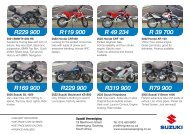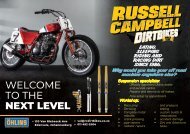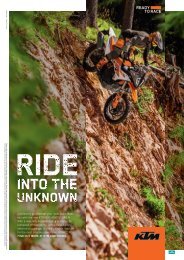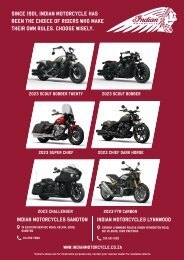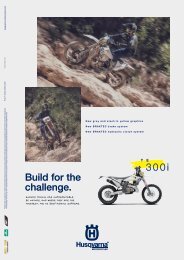Create successful ePaper yourself
Turn your PDF publications into a flip-book with our unique Google optimized e-Paper software.
Engine:<br />
With an extra 42cc over the outgoing Tracer models,<br />
you’d expect the updated CP3 triple to have more<br />
power and torque. You’d be correct, but thanks to Euro<br />
5 compliance, there’s not a lot in it with just around 3%<br />
more at the top end.<br />
It is, however 2kg lighter than the motor used on the<br />
outgoing MT-09 and provides 6% more peak torque, 3%<br />
more peak output and, they say 9% more efficiency. The<br />
fuel injection system is heavily revised, with new injector<br />
banks squirting fuel more or less directly onto the tops of<br />
the intake valves, rather than further upstream in the inlet<br />
tracts. This is claimed to improve fuel atomisation and<br />
reduce the amount of fuel that resists combining with the<br />
incoming air and simply ‘sticks’ to the intake tract wall.<br />
The 6-speed transmission has an assist-and-slipper<br />
clutch and a new quickshifter.<br />
We are not too enthralled with the new square exhaust<br />
boxy type system that sits beneath the engine. We are<br />
pretty sure that that will make way for an aftermarket<br />
pipe straight away and we’d guess that this will unleash<br />
a few more horsepower. Despite the weird pipe it really<br />
does sound the business. The fact that Yamaha has<br />
managed to drop weight, meet Euro 5 emissions targets<br />
and still find a small increase in power tells us that<br />
Yamaha knows their stuff!<br />
Electronics and stuff: It’s a lot but have a read...<br />
Electronics on this bike includes brake, slide and traction<br />
control and are all funnelled through a new 6-axis IMU<br />
that is more compact than the hardware used on the R1.<br />
New for this year is KYB semi-active suspension front<br />
and rear. It’s not the most sophisticated system in the<br />
world, it doesn’t alter preload for example, just damping<br />
but it’s still a nice touch. They tell us that the IMU runs<br />
125 calculations per second, continually feeding data<br />
to the suspension, which electronically adjusts rebound<br />
and compression damping in the fork and rebound in the<br />
rear shock in real-time to suit the terrain and conditions.<br />
It also stabilizes the chassis under braking and<br />
acceleration and offers two modes, (Sport and Comfort).<br />
The IMU also feeds data to the new rider aids which<br />
can be adjusted to preference or completely turned off.<br />
These include lean angle-sensitive traction control, slide<br />
control, wheelie control, and cornering lights. The ABS<br />
is newly equipped with a brake control system, and<br />
riders can choose between two levels of intervention.<br />
Yamaha’s YCC-T throttle-by-wire system now includes<br />
Accelerator Position Sensor Grip, (ASPG), which uses a<br />
sensor and a magnet to detect throttle opening and send<br />
corresponding signals to the throttle valves. ASPG uses<br />
a spring, slider, and gear to produce variable resistance<br />
to the grip creating a natural throttle feel.<br />
You have a choice of 4 different engine modes, Mode<br />
1 is full power and sharpest delivery, through to Mode<br />
4 which makes it feel like it’s only using two out three<br />
cylinders, and three rider aid modes namely TCS 1, TCS<br />
2 and Manual, all accessed via the left-hand switchgear.<br />
TCS 1 is lowest intervention on all aids, TCS2 ramps it<br />
up a bit, and Manual allows you to tailor the whole lot to<br />
your tastes, with a choice of three intervention levels for<br />
each, plus the option to turn the Slide Control and LIF<br />
off while keeping some Traction Control. There’s also an<br />
option to just turn the whole lot off.






